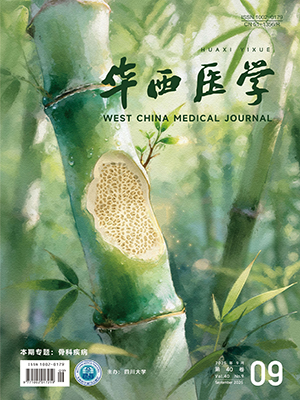| 1. |
Roy M, Chatterjee M, Deb S, et al. Encephalitis following wasp sting. Indian J Pediatr, 2010, 77(10): 1193-1194.
|
| 2. |
Xuan BH, Mai HL, Thi TX, et al. Swarming hornet attacks: shock and acute kidney injury-a large case series from Vietnam. Nephrol Dial Transplant, 2010, 25(4): 1146-1150.
|
| 3. |
彭清莲, 陈德政, 张勇. 蜂蛰伤后心肌损伤的临床表现及发病机制. 国际心血管病杂志, 2019, 46(3): 137-141.
|
| 4. |
Xie C, Xu S, Ding F, et al. Clinical features of severe wasp sting patients with dominantly toxic reaction: analysis of 1091 cases. PLoS One, 2013, 8(12): e83164.
|
| 5. |
Mejía Vélez G. Acute renal failure due to multiple stings by Africanized bees. Report on 43 cases. Nefrologia, 2010, 30(5): 531-538.
|
| 6. |
张凌, 付平, 唐万欣, 等. 不同血液净化方式对蜂蜇伤所致急性肾功能衰竭预后的影响. 肾脏病与透析肾移植杂志, 2009, 18(2): 101-105.
|
| 7. |
四川省急诊医学专委会中毒与复苏学组. 四川省蜂螫伤规范化诊治专家共识. 华西医学, 2013, 28(9): 1325-1328.
|
| 8. |
Gong J, Yuan H, Gao Z, et al. Wasp venom and acute kidney injury: the mechanisms and therapeutic role of renal replacement therapy. Toxicon, 2019, 163: 1-7.
|
| 9. |
Truche AS, Darmon M, Bailly S, et al. Continuous renal replacement therapy versus intermittent hemodialysis in intensive care patients: impact on mortality and renal recovery. Intensive Care Med. 2016, 42(9): 1408-1417.
|
| 10. |
Zhang L, Yang Y, Tang Y, et al. Recovery from AKI following multiple wasp stings: a case series. Clin J Am Soc Nephrol, 2013, 8(11): 1850-1856.
|
| 11. |
Yuan H, Chen S, Hu F, et al. Efficacy of two combinations of blood purification techniques for the treatment of multiple organ failure induced by wasp stings. Blood Purif, 2016, 42(1): 49-55.
|
| 12. |
Kellum JA, Lameire N, Aspelin P, et al. Kidney disease: improving global outcomes (KDIGO) acute kidney injury work group. KDIGO clinical practice guideline for acute kidney injury. Kidney Int Suppl, 2012, 2(1): 1-138.
|
| 13. |
Bellomo R, Cass A, Cole L, et al. Intensity of continuous renal-replacement therapy in critically ill patients. N Engl J Med, 2009, 361(17): 1627-1638.
|
| 14. |
National Kidney Foundation. K/DOQI clinical practice guidelines for chronic kidney disease: evaluation, classification, and stratification. Am J Kidney Dis, 2002, 39(2 Suppl 1): S1-S266.
|
| 15. |
Inker LA, Schmid CH, Tighiouart H, et al. Estimating glomerular filtration rate from serum creatinine and cystatin C. N Engl J Med, 2012, 367(1): 20-29.
|
| 16. |
Pannu N, Klarenbach S, Wiebe N, et al. Renal replacement therapy in patients with acute renal failure: a systematic review. JAMA, 2008, 299(7): 793-805.
|
| 17. |
Liang KV, Sileanu FE, Clermont G, et al. Modality of RRT and recovery of kidney function after AKI in patients surviving to hospital discharge. Clin J Am Soc Nephrol, 2016, 11(1): 30-38.
|
| 18. |
Nash DM, Przech S, Wald R, et al. Systematic review and meta-analysis of renal replacement therapy modalities for acute kidney injury in the intensive care unit. J Crit Care, 2017, 41: 138-144.
|
| 19. |
Kokot ZJ, Matysiak J, Urbaniak B, et al. New CZE-DAD method for honeybee venom analysis and standardization of the product. Anal Bioanal Chem, 2011, 399(7): 2487-2494.
|
| 20. |
Dhanapriya J, Dineshkumar T, Sakthirajan R, et al. Wasp sting-induced acute kidney injury. Clin Kidney J, 2016, 9(2): 201-204.
|
| 21. |
Silva GBD, Vasconcelos AG, Rocha AMT, et al. Acute kidney injury complicating bee stings: a review. Rev Inst Med Trop Sao Paulo, 2017, 59: e25.
|
| 22. |
Li F, Liu L, Chen D, et al. Efficacy of three renal replacement therapy modalities for the treatment of acute kidney injury caused by wasp sting. Blood Purif, 2022, 51(4): 365-375.
|
| 23. |
Rachaiah NM, Jayappagowda LA, Siddabyrappa HB, et al. Unusual case of acute renal failure following multiple wasp stings. N Am J Med Sci, 2012, 4(2): 104-106.
|
| 24. |
陈德政, 张凌, 李明鹏, 等. 早期强化血液净化治疗重症蜂毒中毒合并急性肾损伤 120 例疗效观察. 中华肾脏病杂志, 2016, 32(11): 833-838.
|
| 25. |
Scharf C, Liebchen U, Paal M, et al. Blood purification with a cytokine adsorber for the elimination of myoglobin in critically ill patients with severe rhabdomyolysis. Crit Care, 2021, 25(1): 41.
|
| 26. |
Dilken O, Ince C, van der Hoven B, et al. Successful reduction of creatine kinase and myoglobin levels in severe rhabdomyolysis using extracorporeal blood purification (CytoSorb®). Blood Purif, 2020, 49(6): 743-747.
|
| 27. |
Chavez LO, Leon M, Einav S, et al. Beyond muscle destruction: a systematic review of rhabdomyolysis for clinical practice. Crit Care, 2016, 20(1): 135.
|
| 28. |
李甫罡, 刘利, 张勇, 等. 蜂蛰伤后临床特点及发生急性肾损伤的危险因素分析. 临床肾脏病杂志, 2017, 17(11): 663-666.
|
| 29. |
Srisuwarn P, Srisuma S, Sriapha C, et al. Clinical effects and factors associated with adverse clinical outcomes of hymenopteran stings treated in a Thai Poison Centre: a retrospective cross-sectional study. Clin Toxicol (Phila), 2022, 60(2): 168-174.
|
| 30. |
Nie S, Feng Z, Xia L, et al. Risk factors of prognosis after acute kidney injury in hospitalized patients. Front Med, 2017, 11(3): 393-402.
|




